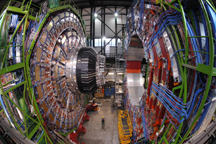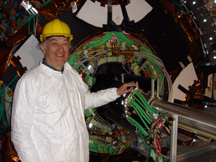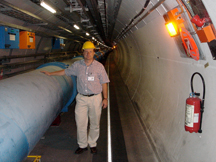Theory of Higgs field earns Nobel Prize, Purdue physicists part of experiment that proved it
October 8, 2013
 |
|
The CMS detector. (Photo courtesy of CERN/Maximlien Brice) |
WEST LAFAYETTE, Ind. — The 2013 Nobel Prize in physics on Tuesday (Oct. 8) was awarded to François Englert and Peter Higgs for their work in developing the theory of the Higgs field, and Purdue University researchers were part of the international experiment that proved its existence.
Purdue's particle physics group has been among the team of international scientists working on experiments at the European Organization for Nuclear Research, or CERN, laboratory and the hunt for the Higgs boson for more than two decades. In July of 2012, their work culminated in an historical moment when representatives of the international collaboration announced the discovery of the Higgs particle, which proves the existence of the Higgs field.
"The prediction of the Higgs field was fundamental and ahead of its time as it has taken 50 years to prove it," said David Miller, a professor of physics at Purdue who was part of the Compact Muon Solenoid, or CMS, experiment at CERN. "Purdue faculty, staff and students who had a hand in the discovery of the Higgs particle are celebrating this Nobel Prize and the brilliance of Peter Higgs and Francois Englert."
 |
|
David Miller, a Purdue physics professor, stands next to the forward silicon pixel detector of the Compact Muon Solenoid detector. Miller and Purdue's particle physics group were involved in designing and building parts of the detector and analyzing and reviewing data from the experiment. (Photo courtesy of David Miller) |
The Higgs field provides the mechanism for how particles get different masses and was one of the last pieces of the Standard Model of particle physics to be proven experimentally, he said.
In addition to Miller, the Purdue particle physics group involved in the CMS experiment includes physics professors Virgil Barnes, Daniela Bortoletto, Laszlo Gutay, Matthew Jones, Norbert Neumeister, Ian Shipsey and professor emeritus Arthur Garfinkel. Many Purdue graduate and undergraduate students and postdoctoral researchers also have been involved in the experiment.
"Purdue particle physicists have been involved with the CMS experiment from concept to building of the detectors to analysis all the way through to the last moments of review before the announcement of the discovery," said Neumeister, who was involved in the internal reviewing process of the analyses that searched for the Higgs boson. "The particle had been predicted for some time and it is simply amazing that it finally materialized, confirming the theory of the Higgs field and earning its creators the Nobel Prize."
The discovery of the Higgs boson has deep implications for how matter in the universe behaves, Jones said.
"The discovery of the Higgs particle was far more than just adding another particle to our collection," he said. "For other particles to have to couple with the Higgs to gain mass means the Higgs field must be permeating all space at all times and is fundamental to space itself."
The discovery of the Higgs particle showed the Higgs field was real and not just a mathematical construct, he said.
"Particles are like ripples on a lake," he said. "We throw a rock, ripples form and we know that the lake exists. The ripples are short lived, but we know the lake remains even when it is still. Through the Large Hadron Collider we were able to throw a rock big enough to create a ripple - the Higgs particle - that tells us the lake - the Higgs field - is out there."
At CERN the Large Hadron Collider, or LHC, crashes protons together at nearly the speed of light to create tiny subatomic particles, some of which had never before been seen. The CMS is one of three detectors at the LHC capturing traces of these collisions and was used in the experiments that led to the Higgs discovery.
Purdue scientists and students contributed to the design and construction of several key parts of the CMS detector, the software used to operate it and analyze the collisions, and have contributed to a variety of key data measurements.
 |
|
Purdue physics professor Norbert Neumeister stands next to the Large Hadron Collider at CERN. Neumeister and Purdue's particle physics group are part of the experiment that discovered the Higgs boson and confirmed the theory of the Higgs field. The 2013 Nobel Prize in physics was awarded to François Englert and Peter Higgs for the development of this theory. (Photo courtesy of Norbert Neumeister) |
Barnes and Gutay contributed key design features to two major components of the detector: the Hadron calorimeters, which detect showers of particles coming from high energy quarks; and the Muon detectors, which detect heavy relatives of the electron, respectively.
Adjunct professors Bortoletto and Shipsey led the camera design and assembly teams. Shipsey is the current chair of the CMS Collaboration Board and Bortoletto is the upgrade coordinator of the U.S. CMS experiment. Both are now professors of physics at Oxford University and were distinguished professors at Purdue at the time of the discovery.
Bortoletto was involved in several of the analyses searching for the Higgs boson, and Neumeister and Shipsey were involved in the internal reviewing process.
Neumeister, in collaboration with Purdue’s information technology group, also contributes to the global distributed computing system that analyzed data from the experiments. The Purdue CMS "Tier-2" data storage and processing center is the largest of its kind among U.S. universities.
"Although the Higgs particle was discovered, many questions remain," Neumeister said. "The Large Hadron Collider has only run at half of the energy of which it is capable and I look forward to what we will find when it starts up again in 2015. Perhaps next we will find something that has not been predicted."
Nearly 2,000 physicists from U.S. institutions, including 89 universities and seven U.S. Department of Energy laboratories, participate in the ATLAS and CMS experiments that discovered the Higgs boson. The discovery was the result of decades of effort by physicists and engineers around the world, at the LHC and also at the Tevatron accelerator located at Fermilab and the Large Electron Positron accelerator, which once inhabited the tunnel where the LHC resides.
Writer: Elizabeth K. Gardner, 765-494-2081, ekgardner@purdue.edu
Sources:
David Miller, 765-494-5556, miller@physics.purdue.edu
Norbert Neumeister, 765-494-5198, neumeist@purdue.edu
Matthew Jones, 765- jones105@purdue.edu
Virgil Barnes, 765-494-5199, barnes@purdue.edu
Related releases:
Purdue physicists part of discovery of new particle that could be Higgs boson
Purdue physicists pursue Higgs boson; part of international CMS experiment
Purdue scientists, students help create a key piece of one of the world’s most powerful cameras
Purdue physicists part of discovery of rare particle decay predicted by the Standard Model
Note to Journalists: Video of Purdue physics professors Matthew Jones and Virgil Barnes discussing the discovery of the Higgs particle and the CMS experiment is available at ftp://news69.uns.purdue.edu/Public/HiggsBoson/

